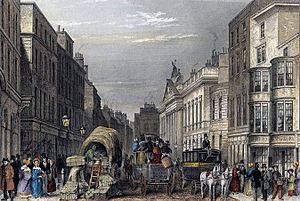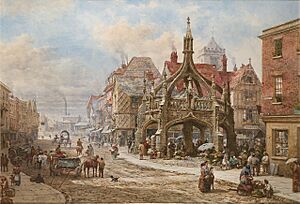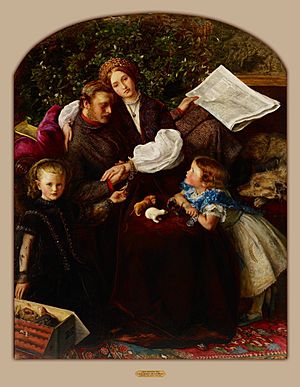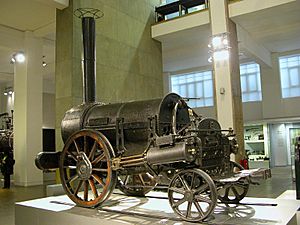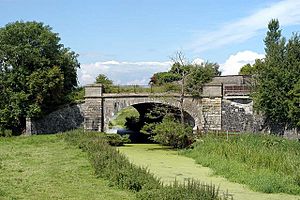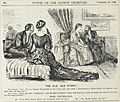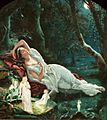Victorian era facts for kids
| 1837–1901 | |
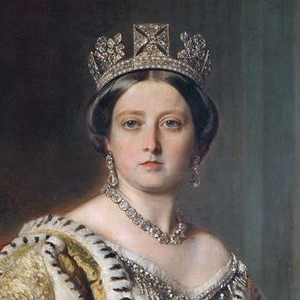
Queen Victoria in 1859 by Winterhalter
|
|
| Preceded by | Georgian era |
|---|---|
| Followed by | Edwardian era |
| Monarch | Victoria |
| Leader(s) | |
The Victorian era was a long period in the history of the United Kingdom. It lasted from June 20, 1837, until January 22, 1901. This was the time when Queen Victoria was on the throne. It came after the Georgian period and before the Edwardian era.
During this time, people became more interested in religion and higher moral standards. New ideas like romanticism became popular, moving away from strict rationalism. The era also saw many amazing inventions. Doctors started using science more, thanks to new ideas like the germ theory of disease.
At home, Britain slowly made political and social changes. More people gained the right to vote. The population of England and Wales almost doubled. Scotland's population also grew a lot. However, Ireland's population dropped sharply. This was mainly because of people moving away and the terrible Great Famine. Many people left Great Britain, mostly for the United States, Canada, South Africa, New Zealand, and Australia. Education improved, and more people learned to read. This led to a huge demand for books and newspapers.
Britain became a very powerful country around the world. It expanded its British Empire in Asia and Africa. This made the British Empire the largest in history. Britain was very confident about its place in the world. It gave some freedom to colonies like Australia, Canada, and New Zealand. Except for the Crimean War, Britain did not fight any big wars with other major powers. The main political parties were the Whigs/Liberals and the Conservatives. By the end of the era, the Labour Party also started.
Contents
A Time of Great Progress
Victoria became queen in 1837 when she was just 18 years old. Her long reign lasted until 1901. It was mostly a time of peace and wealth for many people. There were no major wars. Britain became very strong in terms of its economy, politics, and culture. The British Empire grew even bigger during this time.
Historians call the middle of the Victorian era (1850–1870) Britain's "Golden Years." People became richer, and the country's income per person grew by half. This wealth came from more factories and machines, especially in textiles. It also came from Britain's worldwide trade network. There was peace abroad, except for the short Crimean War (1854–56). There was also peace at home. People who had opposed the government, like the Chartist movement, found new ways to improve things, like joining trade unions. Working-class people did not listen to foreign thinkers like Karl Marx. Instead, they celebrated the new wealth.
Many employers were kind to their workers and accepted trade unions. Companies offered housing, schools, churches, libraries, and even gyms to their employees. Middle-class people tried to help the working classes live more "respectable" lives. People felt very free. Taxes were low, and the government did not control much. Even though there were some problems, like occasional riots, society was still led by the rich and powerful. Being a rich businessman was not as respected as having a noble title and owning land. Literature was popular, but other arts like painting and music were not as big. The education system was not the best, and many universities were just okay.
Population Growth and Changes
The Victorian era saw a huge increase in Britain's population. It grew from 13.9 million people in 1831 to 32.5 million in 1901. This growth happened because of changes in how many babies were born and how many people died. Britain was the first country to go through this "demographic transition." This was helped by the Agricultural and Industrial Revolutions.
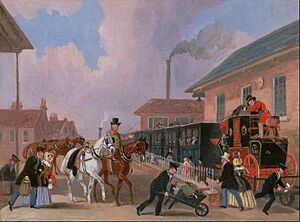
Britain led the way in fast economic and population growth. At the time, Thomas Malthus thought that populations would grow faster than resources. This would lead to problems like famine or war. But Britain avoided this "Malthusian trap." The Industrial Revolution made living standards much better. People had more money and could live better lives. This meant the population increase could be supported.
More Births and Fewer Deaths
In the Victorian era, the number of births went up every decade until 1901. After that, the rates started to level off. One reason for this was that living standards improved. More women were healthy enough to have children. Also, more people got married, and they married at a younger age. One idea is that being more prosperous allowed people to afford marriage and start families earlier. More marriages naturally led to more births.
The number of deaths in England changed a lot during the 19th century. There were no major widespread diseases or famines in England or Scotland. This was the first century without such a disaster. The death rate per 1000 people in England and Wales dropped from 21.9 in 1848-54 to 17 in 1901. Richer people had lower death rates than poorer people.
Health and living conditions improved throughout the Victorian era. Better food might have also helped, though experts still discuss this. Sewage systems and drinking water quality got better. A healthier environment meant diseases did not spread as easily. Technology also improved, and people had more money for medical advances. For example, new methods helped more women and babies survive childbirth. However, there were still cholera outbreaks in London, killing thousands. Tuberculosis, lung diseases from mines, and typhoid were still common.
Religion and Society
Many different Christian churches existed in Britain. The "Nonconformist conscience" was the strong moral influence of these churches on British politics. Nonconformists were Protestants who were not part of the official Church of England. They included Methodists, Baptists, and others. In the 19th century, about half of the people who went to church on Sundays were Nonconformists. They were often from the growing middle class in cities.
These groups pushed for moral changes in politics. They wanted religious freedom and equality. They also fought against unfair rules. They stressed personal morality, like avoiding alcohol and keeping Sundays special. They were very active in politics. At first, some supported the Whigs/Liberals, and others supported the Conservatives. But by the late 19th century, most Nonconformists supported the Liberal Party. This made them a powerful group that pushed for changes, especially in schools and temperance (avoiding alcohol).
Removing Unfair Rules
Parliament had put many unfair rules on Nonconformists. These laws stopped them from holding public jobs. They also had to pay taxes to the Anglican church and be married by Anglican ministers. They couldn't even go to Oxford University or get degrees from Cambridge. Nonconformists worked hard to get these rules removed. The Anglican church resisted for a long time. But in 1828, the "Test and Corporation Acts" were finally removed. This was a big victory for these groups.
Next, they fought against "church rates." These were local taxes to support the Anglican church buildings. People who refused to pay could have their property taken or even be put in prison. Finally, in 1868, William Ewart Gladstone made these payments voluntary. The issue of marriage was solved in 1837. People could now get married by local government officials. Nonconformist ministers could also marry couples if an official was there. Rules about burying the dead were also changed in 1880, allowing Nonconformists to use traditional graveyards.
Oxford and Cambridge universities used to require students to agree with the Church of England's beliefs. This changed over time. London University was started in 1837 without such rules. By the 1850s, Oxford dropped its rules. In 1871, Gladstone helped pass a law that gave everyone full access to university degrees. Nonconformists also helped start new universities in cities like Manchester, Birmingham, Liverpool, and Leeds.
Culture and Art
During this time, Gothic Revival architecture became very important. There was a "Battle of the Styles" between Gothic and Classical designs. The new Palace of Westminster, which was rebuilt after a fire in 1834, was designed in the medieval Gothic style. This showed a link to Britain's past.
The middle of the 19th century saw The Great Exhibition of 1851. This was the first World's Fair. It showed off the amazing new inventions of the century. The main building was the Crystal Palace, a huge structure made of glass and iron. It was the first of its kind. The invention of photography also changed art. Queen Victoria was the first British monarch to be photographed. Photography influenced artists like John Everett Millais and the Pre-Raphaelites. Later, it influenced Impressionistic and Social Realist art.
The Rise of the Middle Class
Industrialization led to a fast-growing middle class. Their numbers changed society a lot, including how people lived and what they valued. Middle-class homes and lifestyles became very distinct. Before, homes and workplaces were often in the same area. Private life and business were not very separate. But in the Victorian era, family life became more private. The home was a separate place for the family. "Privacy" became a key part of middle-class life. Homes were often closed off and only opened for special visits like parties.
Newspapers and News
Four main things changed newspapers in 19th century Britain. First, the government removed high taxes and strict rules by the 1830s. Second, new machines like the rotary press could print thousands of copies cheaply every day. Third, newspapers added new things like features, pictures, and ads to attract more readers. Finally, more men gained the right to vote, and newspapers became the main way to learn about politics.
The Times newspaper became very powerful. It sent war correspondents to cover conflicts. W. H. Russell wrote important reports from the Crimean War (1853-1856). For the first time, people could read about the real conditions of war. Russell wrote about the poor care for wounded soldiers. This shocked the public and led to big changes, especially in nursing, led by Florence Nightingale.
The Manchester Guardian was started in Manchester in 1821. The Daily Telegraph started in 1856. It was the first "penny newspaper" in London, meaning it was very cheap. It made money from ads because so many people bought it.
Fun and Free Time

People had much more free time as wages grew and work hours became shorter. In cities, a nine-hour workday became common. The 1874 Factory Act limited the workweek to 56.5 hours. This encouraged the idea of an eight-hour workday. Also, people started getting regular yearly vacations. This began with office workers and then spread to the working class. About 200 seaside resorts appeared. This was thanks to cheap hotels, affordable train tickets, and more public holidays.
By the late Victorian era, the entertainment industry grew in all cities. It offered planned shows that were suitable, easy to get to, and cheap. These included sports events, music halls, and popular theater. By 1880, football (soccer) was no longer just for the rich. It attracted huge working-class crowds. Professional sports became common. New activities like lawn tennis and golf became popular for amateurs. Women were also allowed to play some sports, like archery and gymnastics.
Amazing Technology and Engineering
Victorians loved science and progress. They believed they could improve society just like they improved technology. Britain was a world leader in engineering. British companies were in demand worldwide to design and build railways.
A key development was better communication. New railways moved goods, raw materials, and people quickly. This helped trade and industry grow. Trains also changed society. "Railway time" became the standard for clocks across Britain. Steamships like the SS Great Britain made international travel more common. They also helped trade, bringing in everyday goods like corn and cotton. Another important invention was the Penny Black, the first postage stamp. It made postage the same price no matter the distance.
Later inventions like electric power, the telegraph, and telephones also had a big impact. Photography was invented in 1839. By 1889, small, hand-held cameras were available.
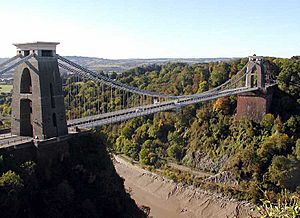
Improvements in sanitation were made in crowded cities. This was thanks to Public Health Acts in 1848 and 1869. Soap became a popular product in new advertisements. A huge engineering success was the sewage system in London. Joseph Bazalgette designed it in 1858. He planned to build 82 miles (132 km) of main sewers linked to over 1,000 miles (1,600 km) of street sewers. Many problems came up, but the sewers were finished. After this, Bazalgette designed the Thames Embankment. It held sewers, water pipes, and the London Underground. London's water supply also improved. Gas for lighting and heating was introduced in the 1880s.
The planned town of Saltaire was built. It had good sanitation and many public, educational, and fun facilities. Science also grew into the field we know today. Many Victorian gentlemen studied natural history. This study was greatly advanced by Charles Darwin and his theory of evolution. He published it in his book On the Origin of Species in 1859.
Gas lighting became very common in homes, factories, public buildings, and on the streets. The invention of the incandescent gas mantle in the 1890s made gas lights much brighter. Hundreds of gasworks were built across the country. In 1882, incandescent electric lights were brought to London streets. But it took many years for them to be everywhere.
Life in Poverty
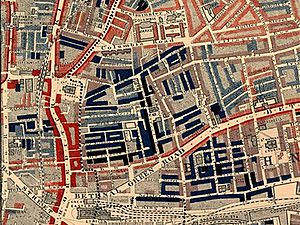

Britain in the 19th century saw a huge population increase. Cities grew very fast because of the Industrial Revolution. Wages slowly got better. Real wages (after considering price changes) were 65 percent higher in 1901 than in 1871. Many people saved their money. The number of people with savings accounts grew from 430,000 in 1831 to 5.2 million in 1887.
People moved into industrial and commercial cities faster than houses could be built. This led to overcrowding and poor sanitation. Clean water and sewage systems were not good enough. Death rates were high, especially for babies. Diseases like cholera and typhoid were common. Large houses were divided into many small flats, and landlords often did not keep them in good repair. This created slums. One writer, Kellow Chesney, said: "Hideous slums... make up a substantial part of the metropolis... In big, once handsome houses, thirty or more people of all ages may inhabit a single room."
The Poor Law system in Britain changed a lot. Many workhouses (or poorhouses in Scotland) were built. These were places where poor people could live and work.
Child Labor
In the early Victorian era, before reforms in the 1840s, many young children worked in factories and mines. They also worked as chimney sweeps. Child labor was a big part of the Industrial Revolution. For example, the famous writer Charles Dickens worked in a factory at age 12. His family was in a debtors' prison. Reformers wanted children to go to school. In 1840, only about 20 percent of children in London went to school. By 1860, about half of children aged 5 to 15 were in school.
Poor children were expected to help their families earn money. They often worked long hours in dangerous jobs for very little pay. Small, agile boys were used by chimney sweeps. Tiny children crawled under machines to pick up cotton bobbins. Children also worked in coal mines. They crawled through tunnels that were too narrow for adults. Other children worked as errand boys, shoe shiners, or sold cheap goods. Some children became apprentices in trades like building. Many worked as domestic servants. Working hours were very long. Builders might work 64 hours a week in summer. Domestic servants were often on duty 80 hours a week.
In 1802 and 1819, "Factory Acts" were passed. These laws tried to limit children's working hours in factories to 12 hours a day. But these laws did not work very well. After protests, a Royal Commission in 1833 suggested new rules. Children aged 11–18 should work a maximum of 12 hours a day. Children aged 9–11 should work a maximum of eight hours. Children under nine should not be allowed to work at all. However, this law only applied to the textile industry. More protests led to another law in 1847. This law limited both adults and children to 10-hour working days.
Victorian Morality
The Victorian era is known for its strong personal moral standards. Historians generally agree that the middle classes had high moral standards and usually followed them. But they debate whether the working classes did the same. Some people in the late 19th century said that slums had high rates of people living together without being married. They also said there were many children born outside of marriage. However, new research shows that these rates were actually quite low for the working class and the poor.
Key Events of the Era
- 1832
- The first Reform Act is passed, changing voting rules.
- 1837
- Queen Victoria becomes queen.
- 1839
- The First Opium War (1839–42) begins between Britain and China.
- 1840
- Queen Victoria marries Prince Albert.
- 1840
- New Zealand becomes a British colony.
- 1841
- The Queen's first son, Prince Albert Edward, is born.
- 1842
- The Mines Act of 1842 stops women and children from working in mines.
- 1845
- The Irish famine begins. It causes many deaths and much emigration.
- 1846
- The Corn Laws are removed, making food cheaper.
- 1848
- A cholera outbreak kills many people.
- 1851
- The Great Exhibition is held at the Crystal Palace in London.
- 1854
- The Crimean War begins between the United Kingdom and Russia.
- 1857
- The Indian Mutiny happens in India. India then comes under direct British rule.
- 1859
- Charles Darwin publishes On the Origin of Species, introducing his theory of evolution.
- 1861
- Prince Albert dies. Queen Victoria mourns him for many years.
- 1865
- Lewis Carroll's Alice's Adventures in Wonderland is published.
- 1867
- The Constitution Act, 1867 passes, making British North America the Dominion of Canada.
- 1875
- Britain buys Egypt's shares in the Suez Canal.
- 1876
- Alexander Graham Bell patents the telephone.
- 1879
- The Battle of Isandlwana takes place during the Anglo-Zulu War.
- 1881
- The British are defeated at the Battle of Majuba Hill, ending the First Boer War.
- 1882
- British troops begin to occupy Egypt to protect the Suez Canal.
- 1884
- The Fabian Society is founded to promote socialism.
- 1885
- The first electric tram service starts in the UK.
- 1886
- Prime Minister William Ewart Gladstone tries to pass the First Irish Home Rule Bill, but it fails.
- 1889
- Emily Williamson founds the Royal Society for the Protection of Birds.
- 1870–1891
- Basic State Education becomes free for children under 10.
- 1899
- The Second Boer War begins between the British Empire and the two Boer republics.
- 1901
- Queen Victoria dies, ending the Victorian era. Her son, Edward, becomes king.
Images for kids
-
The restoration of the Catholic hierarchy in 1850 caused a strong reaction. This sketch is from Punch, November 1850.
-
Thomas Henry Huxley's famous debate in 1860 with Samuel Wilberforce helped people accept Charles Darwin's theory of evolution.
-
George William Joy's painting The Bayswater Omnibus, 1895, shows middle-class social life.
-
An 1884 cartoon from Punch about a romance between a former Cambridge University Senior Wrangler and a former Girton College student.
-
Edinburgh Ale, 1844 by David Octavius Hill and Robert Adamson.
-
Rugby football match between England and Scotland, c. 1880.
-
Michael Faraday giving a Christmas Lecture at the Royal Institution.
-
Monarch of the Glen (1851) by Edwin Landseer.
-
Miranda (1875) by John William Waterhouse.
-
Biondina (1879) by Frederick Leighton.
-
God Speed! (1900) by Edmund Leighton.
-
The British Empire's submarine telegraphic cable network connected its major possessions.
See also
 In Spanish: Época victoriana para niños
In Spanish: Época victoriana para niños


